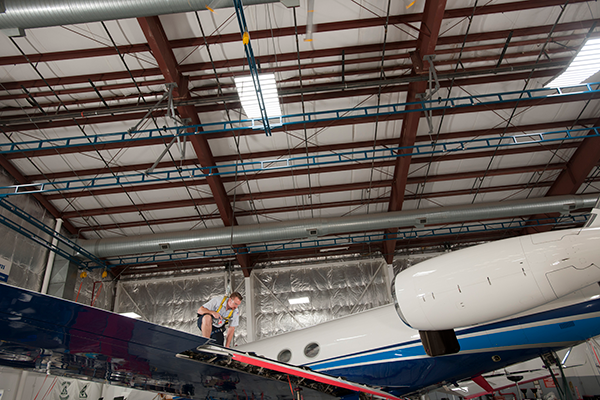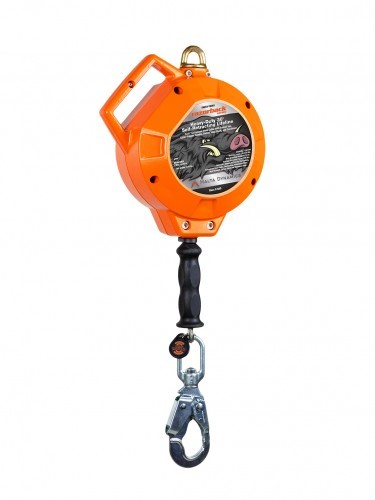
Choosing the Right SRL for your Fall Protection System and Application
May 10, 2018
SRLs, or self-retracting lifelines, are a crucial part of any fall protection system. SRLs connect workers to their anchor point and arrest falls with a built-in braking system. Every fall protection application is different, so it is important to know how to choose the right SRL for your specific application.
It’s worth noting that Rigid Lifelines Fall Protection Systems are designed to be used with SRLs rather than shock-absorbing lanyards. SRLs can limit fall distances to several inches when no freefall event occurs, making them safer than fixed-length lanyards for use on Rigid Lifelines Anchor Track Systems.
What to Look for
There are a few factors to consider when choosing the right SRL. One factor is the use of fall indicators. A fall indicator is a small device attached to the SRL that activates when a fall has occurred. It is a visual indicator that is easy to see and is usually colored red or another highly visible color.
A fall indicator is important to ensure that every fall is properly reported, as an SRL that has an activated indicator must be removed from service and checked by a competent person* who is not the user. Use an SRL with a fall indicator for safest operation.
Other factors to consider are the hooks and connectors on an SRL. The safest SRLs use hooks and connectors that can swivel both at the connection between the SRL and the fall protection system and between the SRL and the harness. This swiveling allows the user to turn while working without the risk of twisting or tangling the lifeline.
Application Options
You should always consider the specific application when choosing an SRL. Knowing the environment, the attachment point, exactly what the worker does, and the required location of the fall protection are crucial to choosing the correct SRL.
There are different styles of SRLs that can be used for different applications. For instance, web SRLs are ideal for jobs involving aircraft, such as aircraft cleaning or maintenance, because the web lifelines can protect aircraft from scratches caused by cables. SRLs are also available with steel cable lifelines.
Different applications can also require different attachment points. Some leading edge SRLs, or SRL-LEs, can attach to a point at foot height to provide protection for jobs along an edge, such as roofing, where overhead fall protection might not be an option. SRL-LEs are also designed to resist damage from  typical structural steel edges and may help prevent tears or cuts in the event of a fall. Extreme caution must be taken when using an SRL-LE; consult the SRL-LE manufacturer for usage instructions and limitations.
typical structural steel edges and may help prevent tears or cuts in the event of a fall. Extreme caution must be taken when using an SRL-LE; consult the SRL-LE manufacturer for usage instructions and limitations.
The environment of a fall protection system can be very important in determining what kind of SRL to use. One instance when special consideration must be made is for coastal or marine environments where the SRL could be exposed to salt water. For any application within five miles of a salt water body, a fall protection system might require an SRL with a stainless steel housing, a web or galvanized cable lifeline, or other forms of protection against rust and corrosion.
Improve Safety
Other features you should look for to improve safety when using an SRL are the ability for self-rescue and ANSI rating. Using the shortest possible SRL for an application helps to reduce fall distance, which makes it easier for workers to self-rescue in the event of a fall. Reducing fall distance also improves safety by reducing the risk of swing fall and the risk of injury after the fall has been arrested.
The ANSI Z359 Fall Protection Code provides a set of standards for SRLs. The Z359.14 standard establishes safety requirements for SRLs, including maximum arrest distance, maximum arresting force (MAF), minimum tensile strength, and other design factors. ANSI Z359.14 also classifies SRLs as either Class A or Class B depending on maximum arrest distance and MAF.
To receive ANSI Z359.14 certification, an SRL must pass multiple testing procedures to ensure it meets all standards. These procedures include drop testing, static tensile testing, average force analysis, and many other safety tests. The testing process also ensures SRLs meet their class requirements. The class rating should be used to match the MAF of an SRL with the MAF of your fall protection system.
Any SRL that is used for fall protection must meet ANSI Z359.14 rating standards; if an SRL does not meet ANSI standards, it should not be considered safe and should not be used for fall protection. Many SRLs are manufactured to ANSI Z359.14 compliance, but it is safest to ensure an SRL is compliant rather than to assume it is compliant.
Inspection
It is necessary to inspect SRLs routinely for damage or wear. SRLs should be inspected before use by the user, and a competent person* should inspect SRLs annually and after a fall event. Always use and inspect an SRL in a mounted position, not when the housing is lying flat.
The first step of the inspection is the fall indicator; if the fall indicator has been activated, the SRL should be removed from service immediately and inspected by a competent person. Next, the housing should be inspected for cracks or other major damage.
If the housing is undamaged, check the labels on the SRL. You should be able to read the date of manufacture, the manufacturer’s name, the serial number, and all warning and specification labels.
The entire length of the lifeline should be inspected for any damage, such as cuts, tears, burn marks, frayed areas, kinks, corrosion, or any other signs of damage. If there is any damage to the lifeline, remove it from service immediately. Use protective gloves when inspected cable lifelines.
Check the tension of the lifeline, and make sure it extends and retracts into the housing smoothly. Then, test the braking mechanism by pulling sharply on the lifeline. Use a handle above the hook to test the brake, as pulling on the hook directly could activate the fall indicator over time. If the lifeline does not retract or lock properly, remove it from service immediately.
Finally, check all hooks, connectors, and other hardware for cracks or damage. If there is damage to any of the hardware or any other part of the SRL, remove it from service immediately. Never use an SRL that is damaged or does not function properly.
A lifeline is an important part of any fall protection system, so you should always make sure you have the best lifeline for your application. Make sure you know all your application needs, maintain your lifeline in good working condition, and follow the manufacturers instructions, and your SRL will help make elevated work conditions safer.
*ANSI defines a competent person as an individual designated by the employer who possesses the proper training and knowledge to identify, evaluate, and address potential fall hazards successfully.
Categories
Share this post
Let us help you
Contact us today to find the perfect product fit for your job
